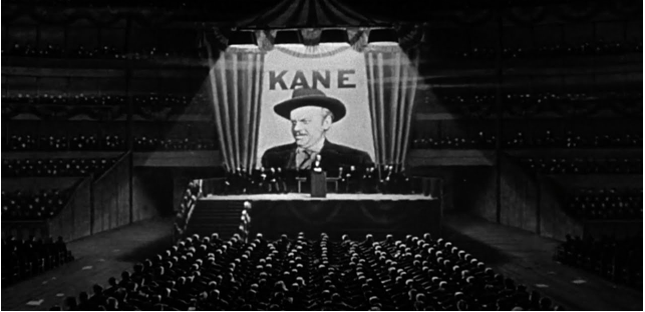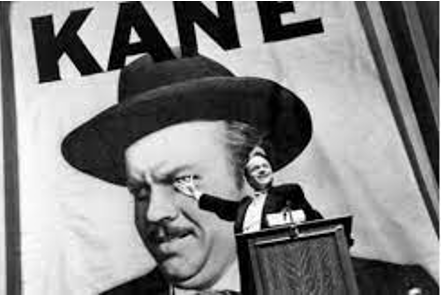Task 1 – Explain how the production context of Citizen Kane influenced the “look and feel” of the end product.
Before ‘Citizen Kane’ Orson Welles achieved a level of notoriety through his acting and direction of many theatre performances across the UK and America. His direction of the radio drama ‘The War of the Worlds’ (1938) shocked American audiences with his ‘authentic’ adaptation of the classic, prompting RKO productions to offer Welles a film contract with almost complete creative control; this project became ‘Citizen Kane’. Welles’ in-depth understanding of theatre and creative control over a substantial budget heavily influenced the final look and feel of the film, as the film showcased many camera techniques and editing styles not yet popular in western cinema; for example, the use of deep depths of field to increase the naturalistic view of the movie, used to mimic how the eye would see a certain scene. Welles also collaborated with industry-leading cinematographer Gregg Toland and renowned editors Robert Wise and Dede Allen to allow ‘Citizen Kane’ to have a high-quality and polished look throughout, in addition to incorporating experimental camera techniques for the period.
Task 2 – Choose your favourite scene from the film and explain why this is the case. You should consider Welles’ use of micro elements in your answer.
My favourite scene from Orson Welles’ ‘Citizen Kane’ would have to be the “Campaign promises” scene as Kane conducts his speech for Governor. Welles uses this scene to effectively depict Kane at the pinnacle of his career, with sweeping pans and medium-paced zooms beginning the scene, setting the grandeur of the ceremony. Gregg Toland utilises low-angle shots to accentuate the political and social power Kane has developed up to this point in his career; in these shots he is portrayed as significantly taller than the rest of his party on stage, further portraying his power over them and showing their dependency on Kane for their own prosperity. The editing in this scene is also heavily significant, with the scene beginning on wide shots of a theatre full to brim with Kane supporters, then to Kane’s speech, then a cut to his watching wife and son. I believe this may be an attempt to foreshadow the downfall of Kane’s career (his infidelity with another woman) as Robert Wise juxtaposes his promises to become elected with shots of his family, possibly to demonstrate that these two parts of Kane’s life cannot co-exist harmoniously.
Task 3 – Why, in your view do you think Citizen Kane is regularly cited by critics as “ the greatest movie ever made” ?
Citizen Kane, unlike many other classic movies of the genre, gained heavy notoriety both from modern audiences and from the movie-goers of the 40’s, as it was said to be one of the most heavily anticipated movies of 1941. Orson Welles’ expertise in the theatrical world allowed for the movie to gain major recognition for its use of staging and acting to reflect changing character dynamics. In addition, ‘Citizen Kane’ also featured camera and lighting expertise from renowned cinematographer Gregg Toland and innovative editing techniques from Robert Wise, elevating Welles’ creative vision. Many critics regard ‘Citizen Kane’ as “the greatest film ever made” as a result of its technical expertise which was regarded as well ahead of its time. In my opinion, ‘Citizen Kane’ is regularly honoured with this title as it reflects the essence of an expertly crafted film which also withstands the test of time; the film’s experimental and ground-breaking nature which shocked audiences during its’ premiere still holds up on modern audiences, portraying how a traditional yet experimental film should be edited and shot. The film blurs the lines between the industries’ standard 2-hour feature film and an excellently crafted cinematographic experience, which hints at subtleties in the changing character dynamics and stays committed to its overall aesthetic and themes. The now overly replicated nature of ’Citizen Kane’ demonstrates its well-deserved titles and accolades, leaving a significant imprint on the industry and spawning many great films in its’ wake.

